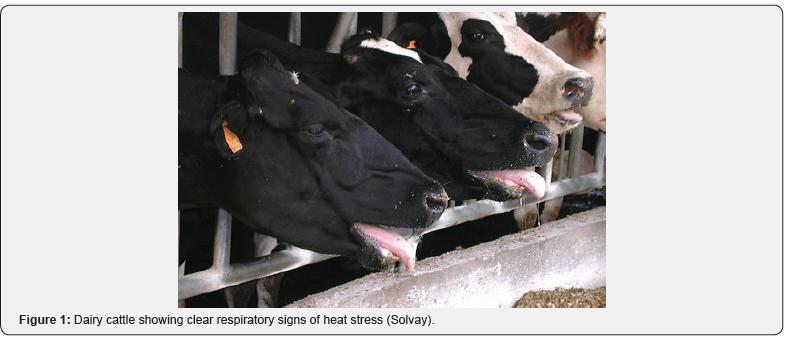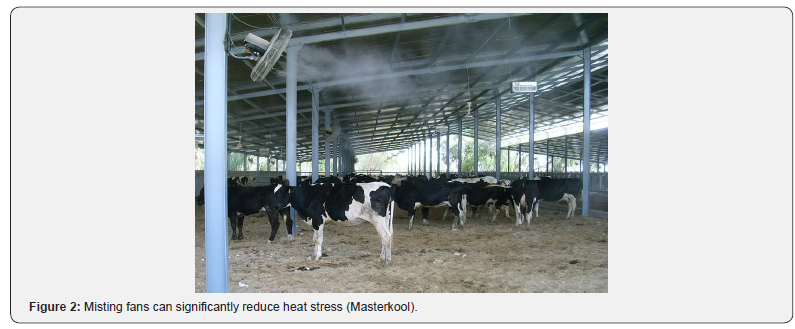Dairy Cow Welfare, Heat Stress and Climate Change- Juniper Publishers
Journal of Dairy & Veterinary Sciences- Juniper Publishers
Abstract
There has been widespread concern in the media
regarding the impact that livestock have on global warming, particularly
with methane from ruminants noted as a potent greenhouse gas. Less
public debate has occurred however, on the potentially negative impact
that global warming will have, indeed is having, on livestock welfare.
Here we will first briefly discuss the effect of livestock husbandry on
climate change before moving to a more detailed discussion of the effect
that a warmer climate is likely to have, again is currently having, on
the physiology and welfare of cattle across the world. Finally, we will
briefly discuss measures that can be taken to reduce the impact of
temperature increase on dairy cattle.
Introduction
Recent research has estimated that while cattle
provide just 18% of the world’s dietary calories and 37% of protein,
they use a huge proportion (83%) of agricultural land and produce 60% of
agricultural greenhouse gas emissions [1]. Understandably, given these
figures, most public concern regarding cattle and climate change has
focussed on the animals as an important causative agent with broadcast
media highlighting the problem [2]. Public
understanding of the impact of global warming on cattle welfare is
significantly less, although some newspapers have noted the problem [3].
The effects of heat stress on beef and dairy cattle have been
recognised by the farming industry for some time but the link with
increasing ambient temperature is only recently being highlighted. Here
we look at the effects of heat stress on cattle and the impact that
global warming will have, indeed is already having, on cattle welfare.
Heat Stress and the Lactating Cow
The lactating dairy cow already has an increased internal
temperature through her milk production (Figure 1). Heat
production through metabolic functions is estimated to account for
around a third of the energy intake of a 600kg cow producing 40kg
of milk daily with a far level of 4% [4]. A study comparing cows
that were non-lactating, or at low (18.5kg/d) or high (31.6 kg/d)
milk yield showed that low and high yielding cows generated 27
and 48% more heat than nonlactating cows even though they had
a lower body weight [5]. Whilst in cold environments dissipation
of such body heat is not a problem, during periods of elevated
ambient temperature, heat loss can be a significant problem
for dairy cattle. The limiting factor for cattle at peak lactation is
energy intake and a common management practice is to increase
energy density of the diet by decreasing forage and giving a
mixed ration with a high energy density. A side effect of feeding
such a high energy ration is that of increased heat production;
Reynolds and colleagues showed that heat production for heifers
ingesting 4 and 7kg dry matter per day was around 40 and 56MJ/d
respectively [6].

The irony, if we are aiming to increase dietary intake in cattle
living on the metabolic knife edge of maximum productivity, is
that heat stress leads to reduced feed intake, decreased activity
and increase in peripheral blood flow to aid perspiration [7] while
decreasing portal blood flow taking nutrients from the intestines
to the liver [8]. Lough’s 1990 paper also showed a reduced
vascular supply to the mammary gland in times of heat stress,
reducing milk production. Other effects of heat stress on lactation
include a decline in plasma somatotrophin and triiodothyronine
and thyroxine [9]. Heat stress alters blood acid-base balance, since
panting animals lose carbon dioxide and thus have a respiratory
alkalosis [10]. Compensation for this involves increased renal
excretion of bicarbonate in times of heat stress, leading to a
paradoxical metabolic acidosis during the cooler hours of nighttime.
This in turn leads to a loss of bicarbonate buffering capacity
which can be critical if cattle are being fed high grain rations. To
add to the cow’s electrolyte compromise, potassium loss through
increased sweating can lead to hypokalaemia [11].
What impact do these metabolic changes in heat stress have
on the affective status of the animal? As far back as 1968 Collins
and Weiner suggested that acute heat stress had emotional effects
on dairy cattle [12] and subsequent work confirmed that heatstressed
cattle have higher cortisol levels than animals kept in
cooler environments [13]. Animals with a reduce dry matter intake
during heat stress are not only physiological stressed, losing body
weight, but also emotionally affected by hunger [14]. We know that
cattle given a limited grazing period have higher plasma levels of
ghrelin, the ‘hunger hormone’ [15] and it is reasonable to assume
that cattle reducing their dietary intake through heat stress will
experience the same endocrinologic and affective state. Thirst too
is a classic response to heat stress and providing adequate water is
essential [16] with chilled drinking water alleviating both thermal
issues and thirst [17,18]. Stermer’s research [17] was undertaken
more than thirty years ago and yet it must be asked how many
farms are providing chilled water for their dairy cattle in times of
heat stress. Such information is difficult to access, but this author’s
impression is that few are.
What influence does heat stress have on lameness and pain
in dairy cattle? Heat-stressed cattle increase their standing time
to allow greater body surface area to be exposed to the air for
heat loss by convection. Lying time is reduced by 30% with higher
ambient temperatures [19] and increased periods of standing
have been suggested as a significant risk factor for lameness which
is already a substantial cause of pain in a sizeable proportion of
dairy cattle [20]. It has been suggested that the conflict between
whether to stand up and increase cooling or to lie and relieve
pain form lameness might be a significant factor in frustration in
dairy cattle, a potentially important affective influence on their
welfare [21]. Leg stomping, weight repositioning and butting,
potential behavioural indicators of frustration, have been noted
in cattle deprived of the opportunity to lie [22] and it would be a
valuable exercise to assess the prevalence of such behaviours in
heat stressed cattle as compared with the same animals in cooler
environments.
Heat stress also reduces fertility in cattle. While results of
research on the effect of heat stress on reproductive endocrine
status have been varied, plasma luteinising hormone pulses
have been shown to be of lower amplitude and frequency in
periods of high ambient temperature [23] and plasma oestradiol
concentrations are lowered by heat stress in dairy cows. Plasma
progesterone levels are influenced by food intake and hepatic
metabolism as well as luteal function, so the influence of heat stress
on progesterone production is complex, but effects of heat stress
on this hormone will affect the survival of an implanting fetus
in the uterine wall as well as oocyte formation with deleterious
effects on oocyte maturation and embryonic death.
Opportunities to Alleviate These Issues
Ambient temperature increases are to be expected in the
future, so one must ask what measures can be put in place to
manage heat stress in cattle. A personal experience might be worth
noting here. On a visit to the Department of Veterinary Medicine
in the University of Khartoum, Sudan I was at first horrified to
see Holstein Friesian cattle, imported from Holland, kept in the
elevated temperatures of this African country. Inspection of the
farms however showed the use of large water misting fans to cool
the cattle (Figure 2). This together with adequate provision of
shade allowed the cattle to live comfortably. Indeed, the human
inhabitants of Khartoum have borrowed that technology and now
use water-cooling fans in up-market restaurants in the city! It is
not only equatorial Africa which is using such technology in the
livestock industry. American and Australian dairy farms are now
also using fan assisted cooling and sprinklers more and more [24].
With an estimated reduction in lactation of up to 35% in midlactating
heat-stressed cows it has been suggested that the US
dairy industry is losing between $900 and $1500 million annually
[25]. Clearly reducing heat stress is not only a welfare issue, but
also a commercial imperative.

To know more about journal of veterinary science impact factor: https://juniperpublishers.com/jdvs/index.php
To know more about Open Access journals Publishers: Juniper Publishers




Comments
Post a Comment